|
SELZ CELEBRATES 200 YEARS
A few German colonists had already arrived in the Kutschurgan valley as early as 1804. But the year 1808 is widely accepted as the founding year for six Catholic Odessa district villages – Strassburg, Baden, Selz, Kandel, Elsass and Mannheim. The first four villages were strung out in close proximity on a north-south line, lying on the east bank of the Kutschurgan liman, a back-water or estuary of the Dniester River. Elsass and Mannheim were located somewhat east and south, along the main road from Tiraspol to the seaport of Odessa.
The first group of German colonists assigned to the task of building the new village of Selz arrived in June 1808. Among the one hundred founding families was a carpenter from Niederlauterbach, Alsace named Michael Fetsch, and his wife Margaretha Sennhauser. Michael Fetsch became the first mayor of Selz, and I am one of his many direct descendants.
On Sunday, September 28, 2008 I was in Selz for its two-hundred-year anniversary celebrations. This was my fourth visit to Selz, which is actually now Limanske on current maps of Ukraine, about 60 kilometers west-north-west of Odessa. Konrad Weiss and Brigetta Fetsch, my father’s parents, were born in Selz, were married there, and had three daughters there, before they emigrated to Canada in 1913.
I have written about
my day in Selz in the December 2008 issue of Heritage
Review, published by GRHS. Following are some
photos of my day in Selz on its Bicentennial Jubilee.
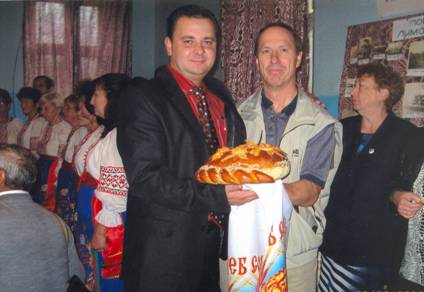
As one of the special guests of the celebration, I was greeted by Mayor Yevgeny Zharikov with the traditional bread and salt (called karovai) on a cloth. For those who recognize her, yes, that is Luise Riesling behind me. Photo courtesy Bob Schneider.
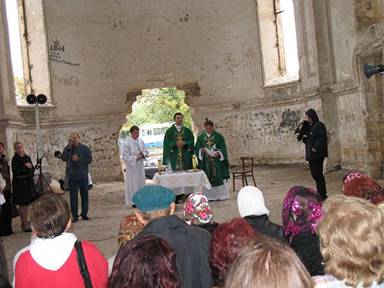
The day started with the Catholic celebration of the Holy Mass inside the ruins of The Church of the Assumption Cathedral in Selz. The sounds of the Latin liturgy and German hymns had not been heard within these walls since 1944. Photo courtesy of Carolyn Schott.
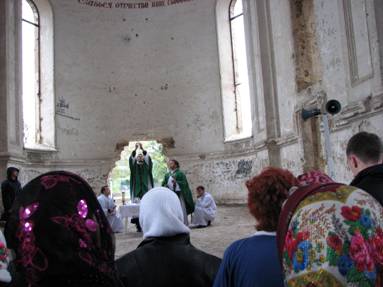
Here in this same church, my grandparents too received Holy Communion. Here too they were baptized and confirmed. My Aunt Ann told me her parents sang in the Choir. This church would have been very important to them. Photo courtesy of Valerie Ingram.
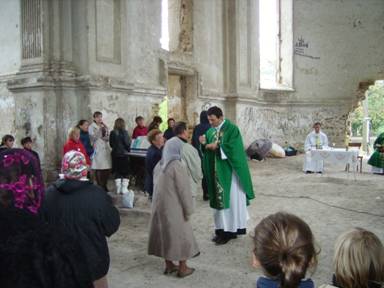
Here I am receiving the sacrament of Holy Communion in the same church where my grandparents once worshipped. Photo courtesy of David Kilwien.
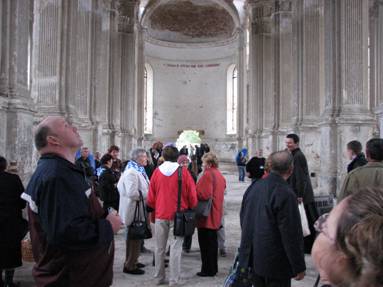
Inside the huge Cathedral, waiting for the Mass to begin. Photo courtesy of Valerie Ingram.
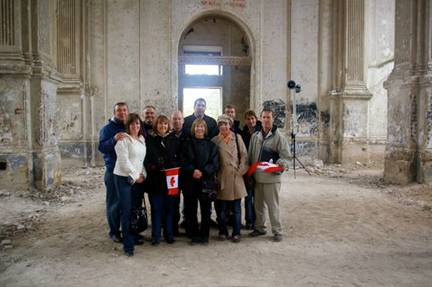
Five Eresman siblings and partners from western Canada were in Selz on this day as well, on their own incredible journey of discovery about the lives of their ancestors. Their ancestral Eresman family lived in Mariental, another German village south of Selz. And this current Eresman family comes from the same Saskatchewan community where I grew up – Fox Valley. Photo courtesy of Darlene Hittel, nee Eresman.
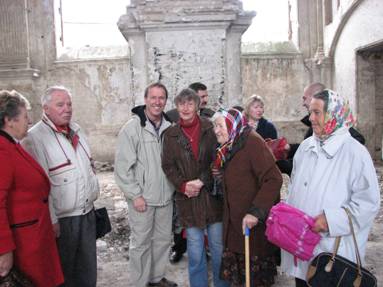
Ninety-six year old
Selz resident Eva
Sander (born 1912) and daughter Vera attended the
Mass as well. Eva has lived in Selz all of her life,
and the rain on this day was not going to keep her from
going to church. She is the daughter of Balthasar
Sander and Philomena Stolz. Vera later sang two songs
(in Russian) as part of the entertainment program. Her
mother Eva was a well-known Odessa Opera singer, and once
sang in the Selz church choir. Photo courtesy of
Valerie Ingram.
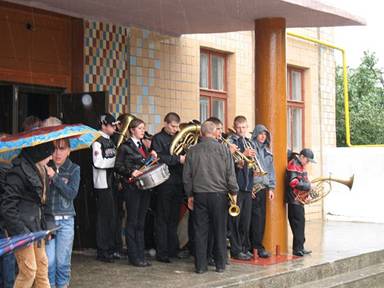
After the Church service, the parade band led us to the Palace of Culture for an afternoon of speeches and entertainment. Photo courtesy of Carolyn Schott.
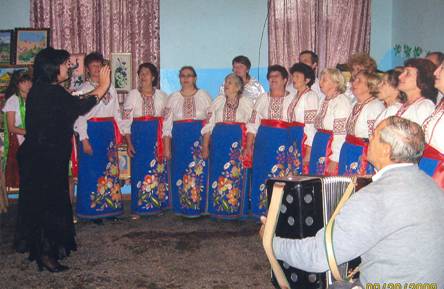
The Director (in black) of this choral group was a thrill to watch in action. Photo courtesy of Bob Schneider.
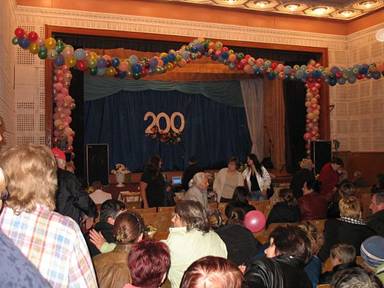
The stage and backdrop in the Palace of Culture. Photo courtesy of Carolyn Schott.
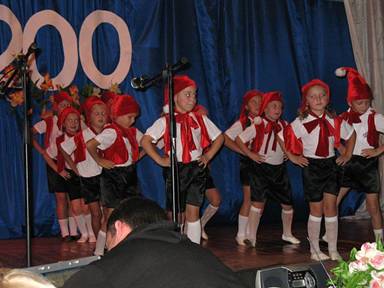
Some lively song and dance routines by the children of the village. Photo courtesy of Carolyn Schott.
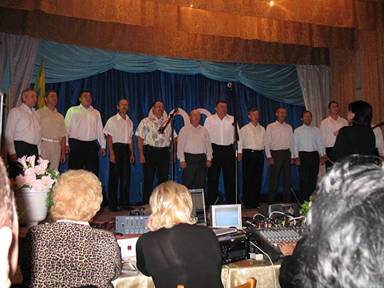
Selz Men’s choral group. Photo courtesy of Carolyn Schott.
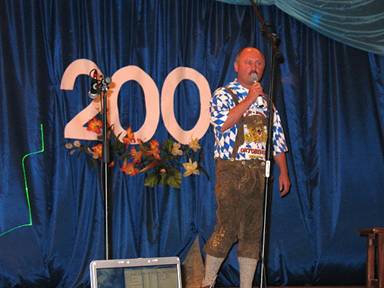
Johannes Derzap of Munich, Germany, in Bavarian dress, told the crowd of 600-700 people about the Germans born in Kazakhstan and other parts of the Soviet Union who have roots in the Kutschurgan district. Photo courtesy of Carolyn Schott.
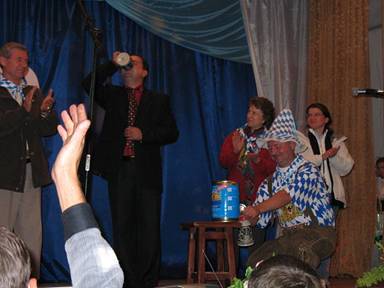
As Derzap draws a stein of beer for himself, Mayor Zharikov quenches his thirst, Bavarian Oktoberfest style! Photo courtesy of Carolyn Schott.
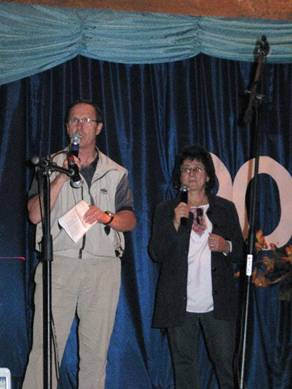
With the help of friend and translator, Inna Stryukova, I told the crowd that five generations of my Weiss and Fetsch families had lived in Selz, and that I would always remember my roots in the beautiful Kutschurgan valley. Photo courtesy of Gayla Aspenleiter.
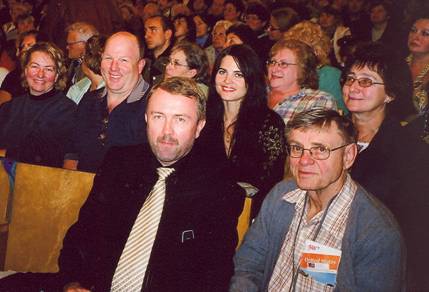
Alexei Köhler
and Robert Schneider, with members of the Schneider Tour
group in the background. Alexei, as Director of the
Institute of Ethnic Research in Odessa, and V-P of the
Association of Ukrainian Germans, represents the interests
of the ethnic Germans of Ukraine. Photo by Merv Weiss.
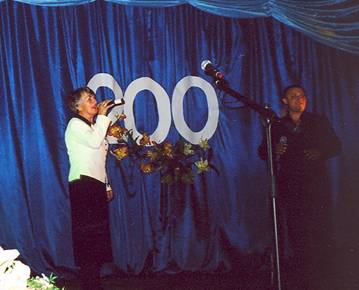
Vera Gonchar, Eva Sander’s daughter, entertained with two songs. Photo by Valerie Ingram.
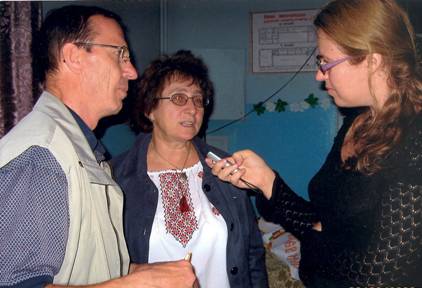
I was interviewed by a newspaper reporter from Kiev, as well as a television station from Odessa. Both reporters asked me to compare the condition of the village today to the time of my grandparents. I interpreted it as a politically-charged question and “side-stepped” it by talking about aspects of the German culture of previous times. Photo courtesy of Bob Schneider.
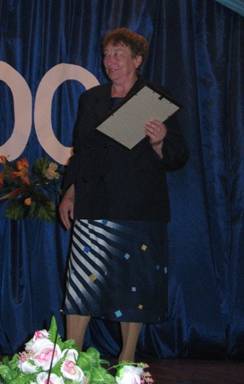
Luise Riesling, resident of Selz since 1992, received recognition from the community for her work in preserving the German history of Selz. Luise lives in the house built by her grandparents Pius Riesling and Regina Jakob. This is a very significant recognition considering the fact that the German presence was never acknowledged by official Soviet history. Photo by Gayla Aspenleiter.
ELSASS – 200 YEARS
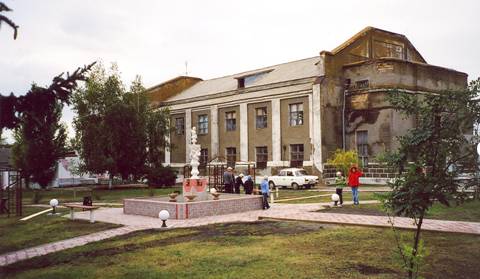
I was in Elsass for an evening program on Saturday, September 27, 2008, by invitation of Mayor Anatoli Witiuk of Scherbanka, as Elsass is now called. Temporary tents had been set up south of the former Catholic Church (pictured above) which held a large photo exhibit of Elsass’s past. There was a large poster displaying the names, in Cyrillic print, of the 73 German colonists who settled Elsass in 1808. Here too I was presented with the traditional bread and salt, and given the opportunity to tell the people about my German ancestors who once lived in the Kutschurgan district. The evening program consisted of speeches intermingled with various musical entertainments. As everywhere, the young dancers and singers brought the loudest applause. Of course, the language of the day was Ukrainian. A group of Germans led by Dr. Johannes Derzap of Munich, Germany was also in attendance. I would estimate the crowd at about 200 people, mostly locals I assumed.
|

